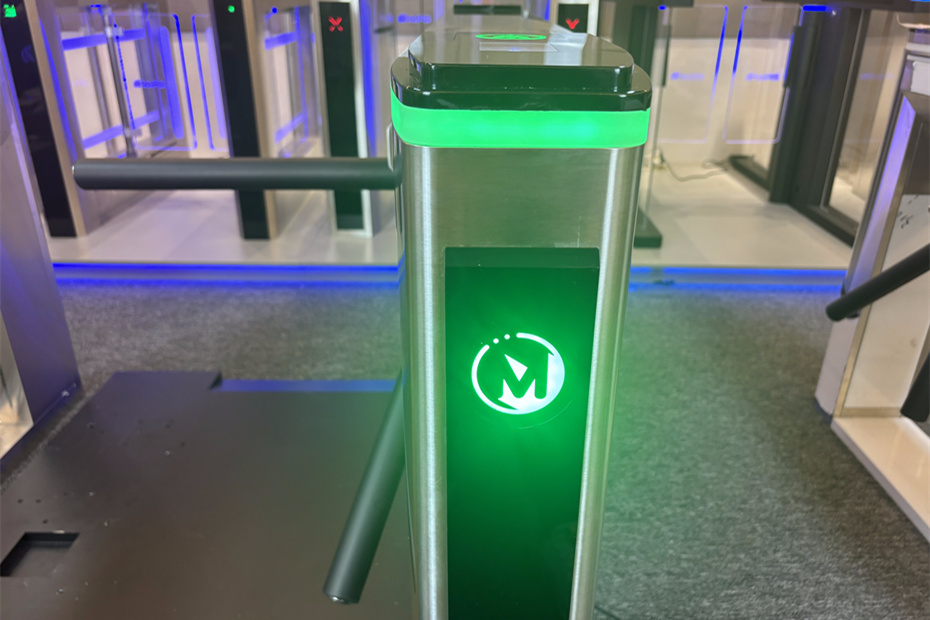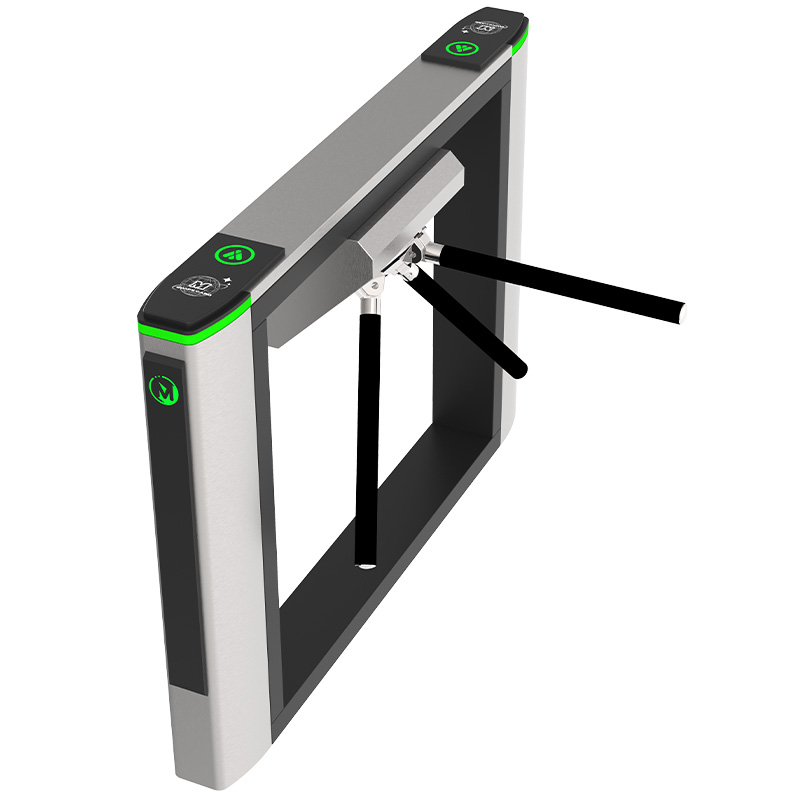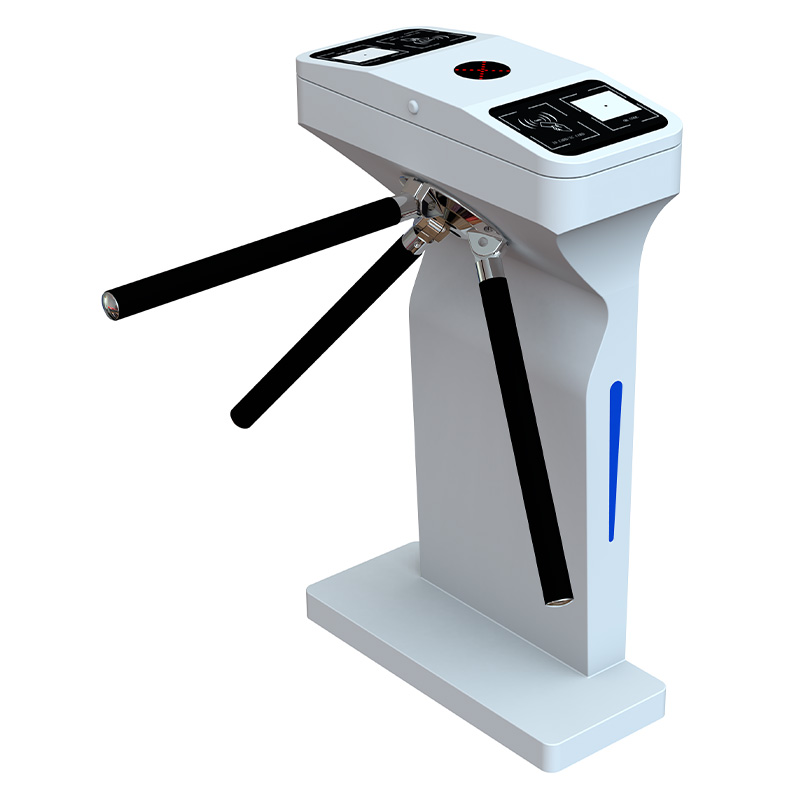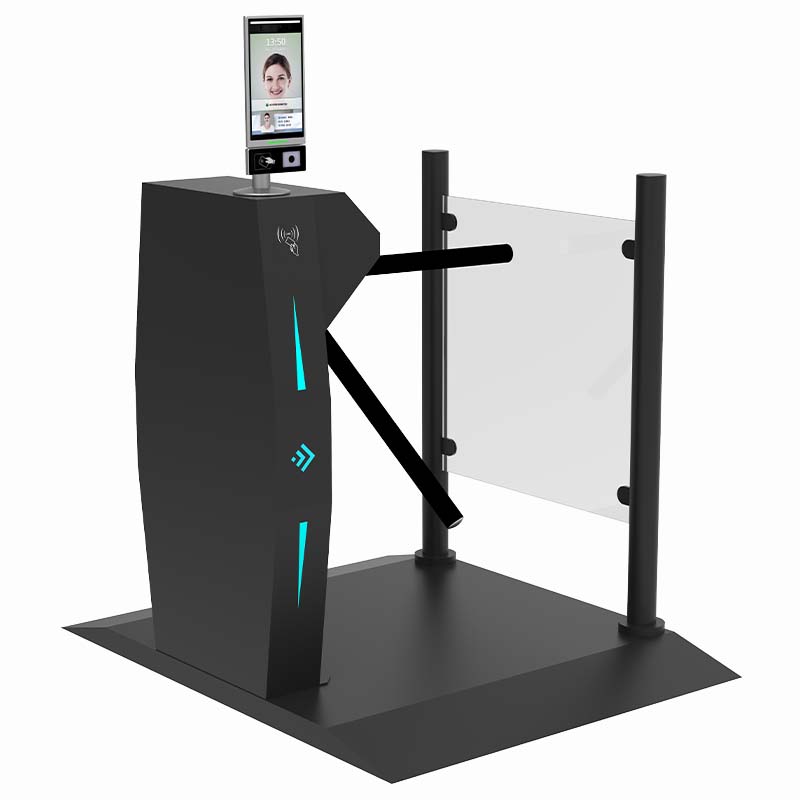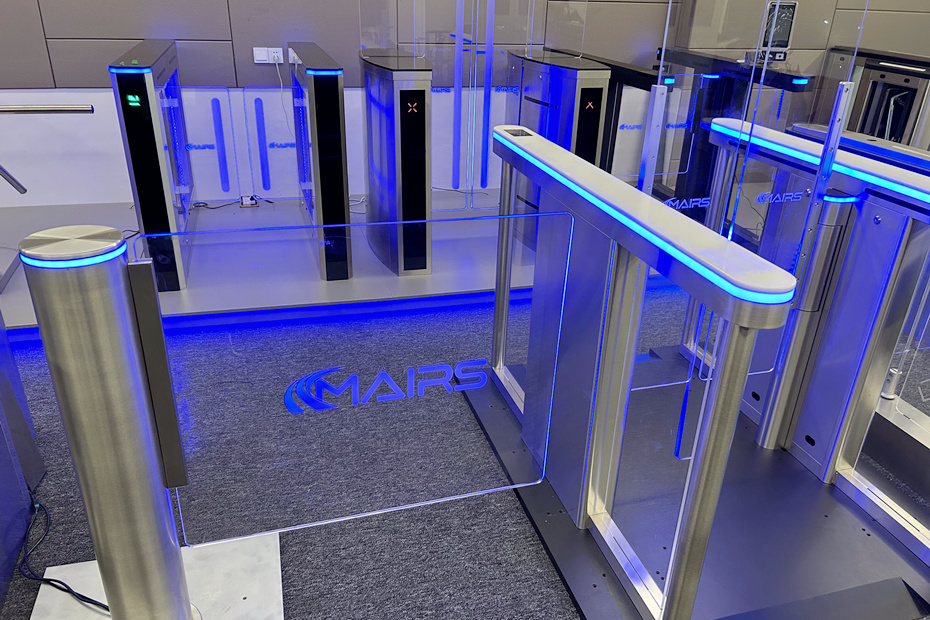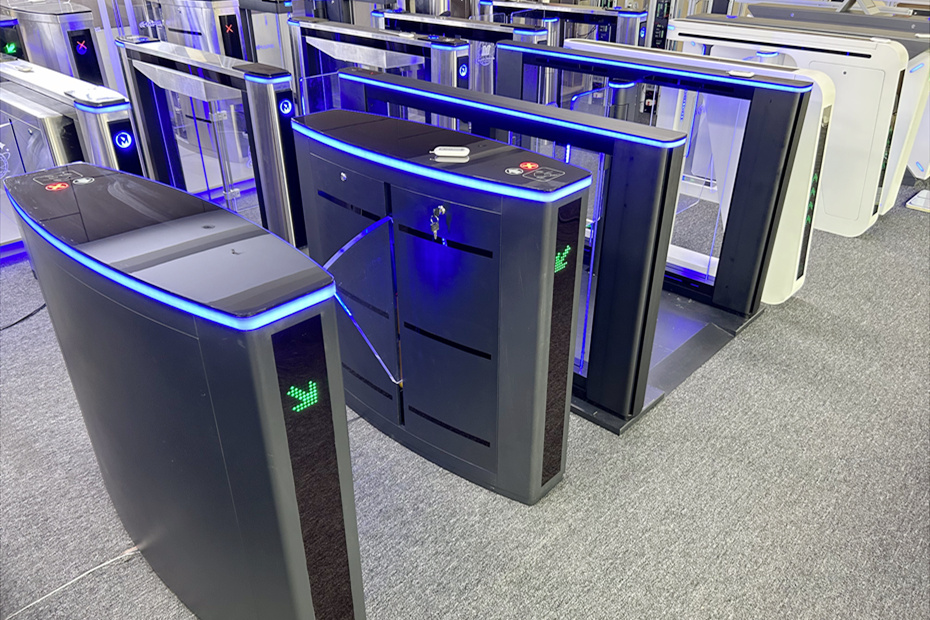Last updated on: April 9th, 2025 16:59 pm
Tripod Turnstile Definition:
Tripod turnstile gate is a kind of pedestrian access control turnstile gate that uses 3 rotatable rods to control the passage. When a pedestrian passes, the rods will automatically rotate and release the passage, and then automatically reset to prevent the next person from passing. The rotating arms rotate 120 degrees each time. The tripod turnstile gate is the most basic and common pedestrian access control turnstile gate, which has 3 rotating arms that can be stopped or released by rotating 120 degrees each time.
The tripod turnstile has a compact structure and occupies little space; Moderate traffic speed, suitable for places with general traffic flow; It has a certain anti-tailgating function. Due to its three-arm design, it is commonly referred to as a “3-arm turnstile.” Typically reaching waist height, it is also known as a waist high turnstile..
The 3 arm turnstile can be combined with a smart card, fingerprint, bar code, and other identification system equipment to form an intelligent access control system; It is combined with a computer, access control, attendance, charge management, ticket system, and other software to form an intelligent access control management system, which can realize the functions of access control, attendance, consumption, ticket sales, current restriction and so on.
Tripod Turnstile Composition:
The components of a tripod turnstile gate include a turnstile chassis, turnstile mechanism, drive control board, motor, limit, direction indicator board, access control part, optional counter, etc. The metal arm (arm’s length standard 50cm) forms a spatial triangle as the blocking body. The tripod turnstile’s chassis is made of 304 or 316 stainless steel, which is durable, not easy to deform, and capable of withstanding external forces.
Among them, 3 rotating arms are located on both sides and in the center. The central arm can rotate, while the arms on both sides are fixed. The motor drives the central arm to rotate through a transmission device, thereby achieving a one-way passage of personnel.
The tripod turnstile chassis is equipped with a direction indicator, read-write installation, infrared sensor, etc; The tripod barrier turnstile gate mechanism is mainly composed of a motor, frame, transmission shaft, and gate as the carrier.
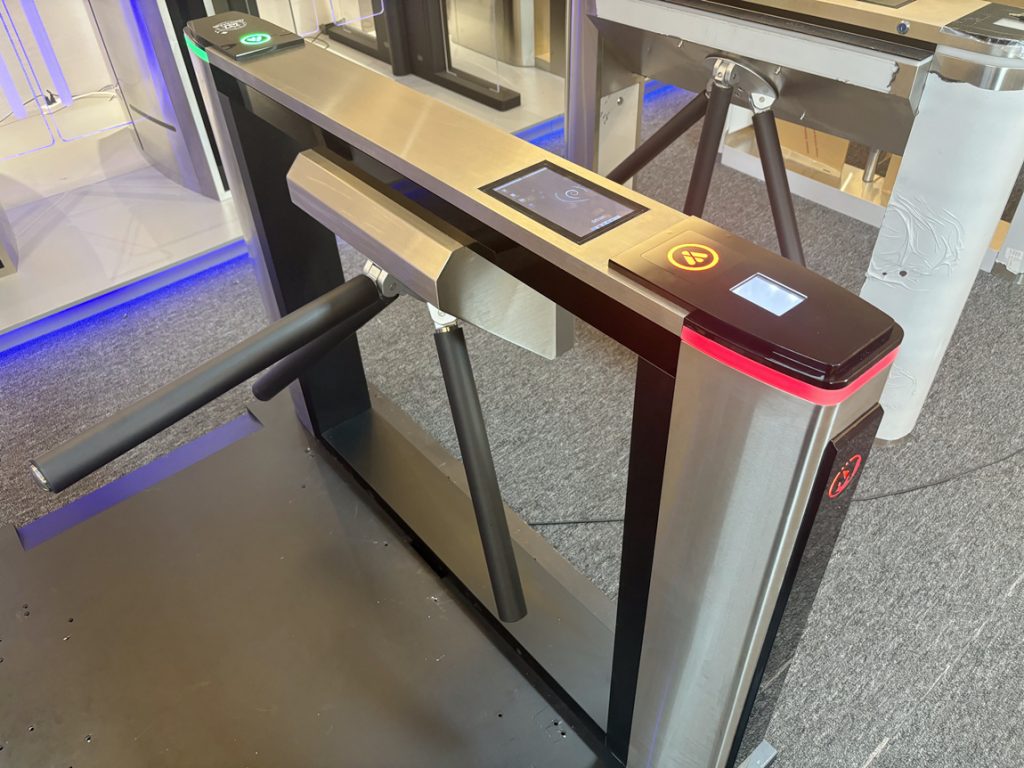
Purchase Suggestions:
With the rapid evolution of society and the widespread adoption of tripod turnstiles for access control, choosing the right tripod arm turnstile becomes crucial. Mairs Turnstile shares valuable insights for both new and existing customers. you can consider the following suggestions to ensure that you choose high-quality equipment that suits your needs:
Clear Requirements:
Clearly define your needs and usage scenarios.
Consider factors like personnel flow, passage mode, and safety requirements.
Choose a Trustworthy Manufacturer:
Opt for a reputable manufacturer known for high-quality products and excellent after-sales service.
Read customer reviews and recommendations to assess the manufacturer’s reputation.
Technical Specifications and Functions:
Review technical specifications and functions, including authentication methods, travel speed, and shock resistance.
Ensure the chosen model meets your specific requirements.
Safety and Reliability:
The Mairs tripod turnstiles prioritize safety and reliability, ensuring minimal damage to maintain a positive image.
Features include stable product quality, power failure and rod drop prevention, emergency evacuation functions, and a high safety factor.
Stable working voltage, excellent voltage stabilizing ability, and strong anti-interference ability contribute to a secure power supply.
Equipped with damping glue, the Mairs tripod arm turnstile operates quietly.
Usability:
Choose a turnstile that is user-friendly and easy to maintain.
Consider factors like the user interface, operation process, and maintenance difficulty.
Appearance:
Aesthetic considerations are essential in modern times. Mairs offers visually appealing designs to complement functionality.
Streamlined ticket inspection gates provide a visual feast, offering high-end elegance and enjoyment.
The machine design minimizes edges and corners, ensuring safety during accidental collisions.
The low base, fixed with reliable expansion bolts, adds to the overall security.
Customized Options:
If you have specific needs, look for a manufacturer that offers customization options.
This could include appearance customization, authentication methods, etc.
After-Sales Service:
Understand the manufacturer’s after-sales service and warranty policy.
Ensure timely access to technical support and maintenance services to minimize downtime.
Cost Benefit:
Consider the overall cost, including purchase, installation, operation, and maintenance costs.
Opt for products with good cost-effectiveness in both short-term and long-term operations.
Adhere to Standards:
Confirm that the chosen turnstile complies with relevant industry standards and regulations.
Ensure it meets local safety and regulatory requirements.
Reference Case:
Review customer cases provided by the manufacturer to understand real-world application effects and user experiences.
This provides insights into the turnstile’s performance in similar scenarios.
By following these considerations, buyers can make informed decisions and choose a tripod arm turnstile that aligns with their specific needs and ensures long-term stability and reliability.

If you are considering purchasing a tripod turnstile, please take some time to contact our professional sales. They will discuss the installation environment and future work requirements, and provide customized quotes based on your needs. Our experienced designers ensure professional design, minimizing your time, communication costs, product design costs, and solution costs, providing an enhanced turnstile user experience.
Tripod turnstile types:
The tripod-type turnstile is categorized into mechanical, semi-automatic, and full-automatic types based on the mechanism control mode. It is further classified into vertical and bridge types based on its form. The vertical tripod turnstile gate is compact and easy to install, while the bridge tripod turnstile gate offers a longer channel and enhanced security.
Automatic Tripod Turnstile:
An automatic tripod turnstile is a kind of tripod barrier turnstile gate equipped with a fully automatic tripod turnstile mechanism, in which all operations of the turnstile machine are completed by the brushless motor.
The automatic tripod turnstile features a fully automated mechanism, with all operations driven by a brushless motor. It conducts self-checks upon powering on and automatically opens and closes during the aging test mode. In card mode, upon receiving an open signal, it opens at a 15-degree angle, gently pushing the arm to fully open. While most tripod barrier turnstile gates in the market are semi-automatic, we offer fully automatic options upon request. Customization according to specific needs is also available.
Semi-Automatic Tripod Turnstile:
Configured with one motor or two electromagnets, the semi-automatic tripod turnstile controls locking and unlocking for both entry and exit directions. Upon authorization, the electromagnet unlocks the passage, allowing the user to gently push the blocking rod in one direction. The design includes an anti-reverse function to effectively prevent pedestrian retrograde.
Manual Tripod Turnstile:
The manual tripod turnstile is purely mechanical, lacking any electrical components. Users can pass through by gently pushing the blocking rod without the need for card swiping. The automatic positioning and reset system controls free passage in one direction, while the other direction remains locked and prohibited.
Why use a tripod turnstile?
The use of the tripod turnstile gate is driven by various features and advantages that cater to the requirements of modern access control. Here are the reasons why the tripod arm turnstile is preferred:
High Safety:
Utilizes fully automatic intelligent motor driving mode with automatic deceleration for durability.
Incorporates an internationally recognized wireless transmission channel, ensuring no radiation hazard to organisms.
The tripod arm turnstile is usually equipped with various identity verification technologies, such as card swiping, induction cards, fingerprint recognition, facial recognition, etc., which improve the security of passage and prevent illegal entry.
Economy:
Lower cost compared to other turnstile types, making it a preferred choice for customers.
Low wiring and installation costs contribute to overall affordability.

Compact design:
The design of the tripod turnstile gate is relatively compact and suitable for limited space places, such as subway stations, shopping malls, office buildings, etc., which can effectively utilize space.
Easy to use:
Simple and modular design, user-friendly for access control administrators with minimal training.
Maintenance is straightforward, with easy fault identification and resolution.
Smart card placement and gentle shaking facilitate fast and convenient personnel access management.
Good Water Resistance:
Designed with effective waterproofing measures for open-air ticket-checking places.
Seamless welding splicing technology and an internal drainage system enhance water resistance, preventing damage to internal components.
Anti-Tailing Technology:
Features practical anti-tailing functionality without the need for additional auxiliary components.
The three-roll design structure eliminates the phenomenon of “trailing,” ensuring one person per rod.
Impact-resistant design:
The mechanical structure of the tripod turnstile gate is relatively sturdy and can withstand some impacts. It requires relatively high stability of the equipment and is suitable for highly frequent traffic situations.
Bidirectional passage:
The tripod turnstile gate can be flexibly set for one-way or two-way passage, making it easy to configure according to actual needs and meet the passage requirements of different places.
Expansion and Practicality:
Easily expands the number of channels with the wireless communication mode. Flexible expansion of intelligent access gates and elevator control equipment.
Diversified Identification Methods:
Integrates multiple identification methods such as IC cards, ID cards, fingerprint identification, QR codes, and face recognition.
Simple card reader installation allows for efficient personnel access management with a response time of less than 0.1s.
Visual barrier effect:
Due to the design of the 3-arm turnstile itself, the 3-arm turnstile forms a relatively good visual barrier effect when closed, which helps to prevent unauthorized personnel from entering at will.
Adaptability to Outdoor Environments:
Designed to withstand outdoor and semi-outdoor environments, including strong light, darkness, rain, high and low temperatures, and significant temperature variations.
In summary, the tripod turnstile gate stands out due to its diverse identification methods, water resistance, anti-tailing technology, ease of use, high safety standards, cost-effectiveness, and adaptability to challenging outdoor conditions. The use of tripod turnstiles can improve traffic efficiency and safety, adapt to the needs of different places, and is a common access control and access control device.

Functions of tripod turnstile:
Personnel access control:
The most basic function of the tripod turnstile gate is to control personnel access, which can only be accessed with authorization. Usually, identity verification methods such as card swiping, induction cards, fingerprint recognition, and facial recognition are required to confirm authorized identity.
Restricted direction of passage:
The tripod turnstile gate can restrict the direction of passage, usually set for one-way or two-way passage. This helps to guide the flow of people in an orderly manner, ensuring that personnel enter and exit in the predetermined direction.
It can be connected to an external switch button or remote control, allowing for one-way or two-way traffic control as needed. The multifunctional design of the tripod arm turnstile ensures not only security but also adaptability to various access control and management requirements.
External Button Control:
The external button allows for the implementation of left and right normally open functions. It can also enable continuous electric rod dropping.
Remote Control and Management:
Remote control and management are achievable directly through a management computer, enhancing operational efficiency.
Anti-Scour Function:
In the absence of an opening signal, the blocking rod automatically locks, providing an anti-scour function.
Automatic Reset Function:
The tripod arm turnstile has an automatic reset feature. Upon unlocking, the blocking rod rotates 120 degrees, automatically resetting and locking. If no passage occurs within a specified time, the system automatically cancels user permission and closes. The delay is adjustable in 5s, 10s, and 20s.
Counting Function:
The control board can be externally connected with a counting function, recording the number of people present. It enables forward plus and reverse minus functions (customizable).
The counting device can be added to the tripod-type turnstile to form a simple turnstile counting system, there are counting devices in each entrance channel and in each control direction
Fault Self-Inspection and Alarm Function:
The tripod barrier turnstile gate is equipped with fault self-inspection and alarm prompt functions, facilitating user maintenance and use. When the system detects illegal passage or other abnormal situations, the tripod turnstile gate can trigger an alarm, and emit sound or light signals, so that security personnel can handle it on time.
Emergency activation:
In emergencies, the 3 arm turnstile is usually designed with an emergency activation function, such as through emergency buttons or special cards, to ensure that personnel can evacuate quickly.
The tripod arm turnstile includes an automatic pole-dropping function after a power failure, meeting fire management requirements. It can also connect to various card reading equipment to receive relay switch signals.
Overall, the tripod turnstile gate achieves effective control of personnel passage through its mechanical structure and identity verification technology, and has efficient and safe passage management functions.
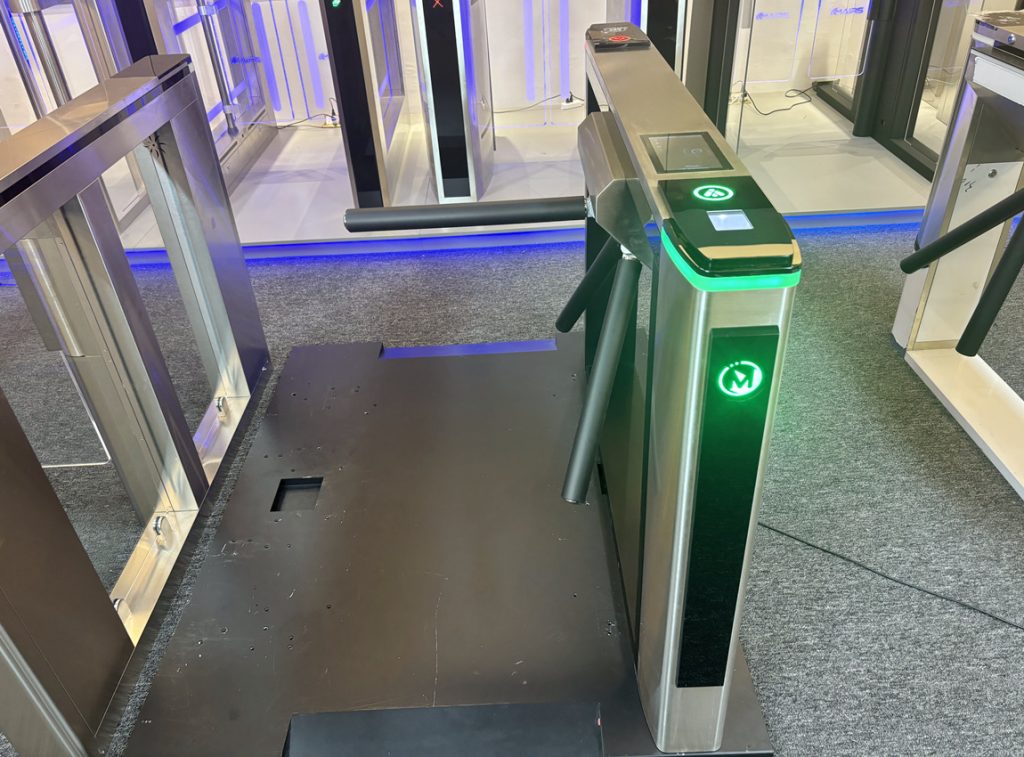
Compared with flap barrier:
The tripod arm turnstile and the flap barrier turnstile serve the common purpose of controlling the smooth flow of people, particularly in areas such as convention halls, hotels, clubs, gyms, wharves, subways, museums, and stations. While they share this common objective, there are notable differences between the two:
1. Channel Function:
Flap Barrier Gate: Designed for convenient towing of luggage, providing a smoother passage for individuals with belongings.
Tripod Arm Turnstile: Less convenient for luggage towing due to its design.
2. Working Mode:
Flap Barrier Gate: Driven by a motor for operation.
Tripod Arm Turnstile: Primarily operates through a combination of metal limit + mechanical reset + manual propulsion.
3. Opening Time:
Flap Barrier Gate: Faster opening and closing times, approximately 0.2 seconds.
Tripod Arm Turnstile: Slower opening and closing times, approximately 1 second.
4. Passage Time:
Flap Barrier Gate: Allows for a faster passage speed, reaching about 55 people per minute.
Tripod Arm Turnstile: Offers a maximum passage speed of about 25 people per minute.
5. Cost:
Tripod Arm Turnstile: Considered an entry-level channel product, suitable for civil-level channels.
Flap Barrier Gate: Positioned as an intermediate product, capable of supporting high-flow areas such as civil-level and rail transit.
6. Performance:
Tripod Arm Turnstile: Primarily serves as dissuasion equipment, providing guidance but lacking advanced safety features.
Flap Barrier Gate: Offers additional safety features, including an anti-climbing alarm, anti-trailing alarm, and anti-pinch electronic eye, making it a product with a higher safety level.
Obviously, while both the tripod arm turnstile and the flap barrier turnstile are employed for access control, they exhibit distinctions in terms of channel function, working mode, opening and passage times, cost, and safety features. The choice between the two depends on specific requirements and the level of functionality and safety needed for a given application.
Disadvantages:
Fixed Passage Width:
The passage width is fixed, and the passage position for personnel is relatively narrow.
Limited Traffic Speed:
Slow traffic speed as only one person can pass at a time.
Restriction on Large Luggage:
Not suitable for people carrying large luggage due to the three-dimensional space closure.
Limited Plasticity of Appearance:
The plasticity of appearance is not strong, and some styles lack aesthetics.
Potential for Climbing:
Can be climbed over, lacking intelligent detection, resulting in a lower security level.
Not suitable for special occasions:
For some places that require large-scale and rapid passage, the tripod turnstile gate may not be as suitable as other types of gates.
Mechanical Collisions (in some models):
Mechanical and semi-automatic models may encounter collisions and loud noise during operation.
Understanding these disadvantages helps in making informed decisions based on specific requirements and use cases.
Application Site:
The tripod barrier turnstile has become an essential modern control equipment for managing the smooth flow of people in various settings. It is deployed in places where controlled entry and exit of personnel are required, providing an organized and civilized passage while preventing unauthorized access. Here are some specific applications where the tripod barrier turnstile gate brings convenience to daily life:
Railway Stations and Transportation Hubs
Supermarkets
Residential Communities
Commercial and office buildings
Government buildings and public institutions
Company Park and Industrial Area
College Libraries
The introduction of the tripod barrier turnstile gate in these diverse settings reflects its adaptability and effectiveness in addressing security and access control needs.
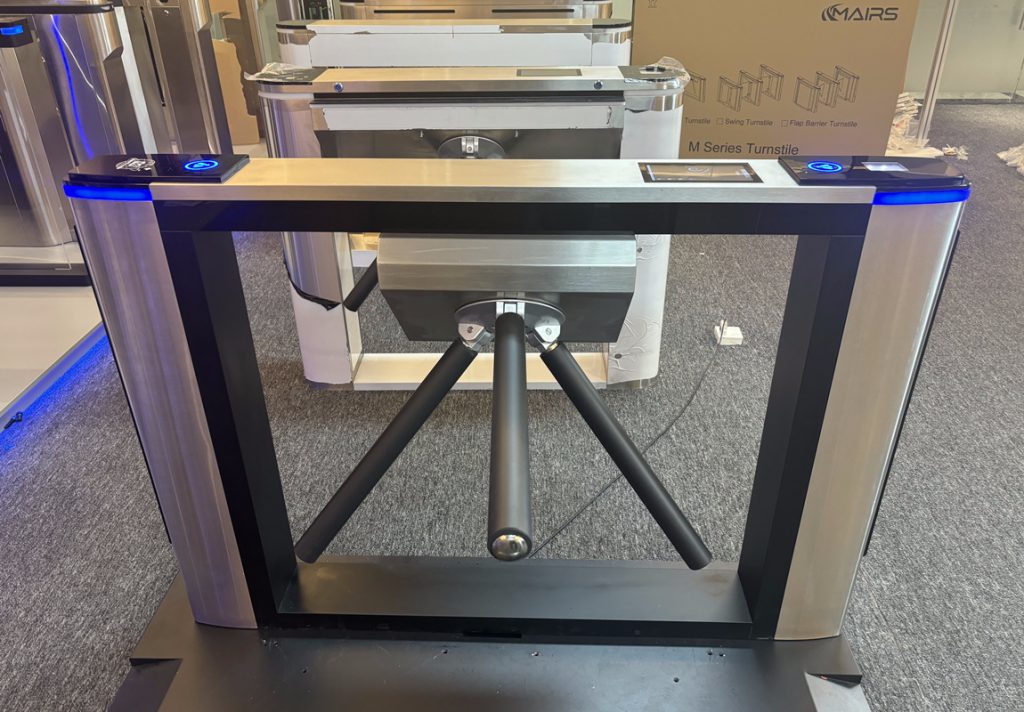
Tripod Turnstile Installation:
The installation of a 3-arm turnstile is an important issue that many customers will consider before purchasing, which also directly affects the use of tripod-arm turnstile equipment in the later stage. The installation of a tripod arm turnstile is a very important link in the whole purchase process. Therefore, we also have a short video on the installation of a tripod arm turnstile, which introduces the various installation processes. We also have an article describing the installation details of the tripod turnstile in detail. Please check our other article: tripod turnstile installation
Tripod turnstile gate demo:
This is a classic tripod turnstile gate that adopts a high-standard manufacturing process, the chassis is made of brushed stainless steel with a sufficient thickness of 2.0mm, which is robust, rigid, anti-rust, waterproof, and durable. We can customize a special tripod turnstile gate according to your actual needs, including logo, size, appearance, material, and color……

